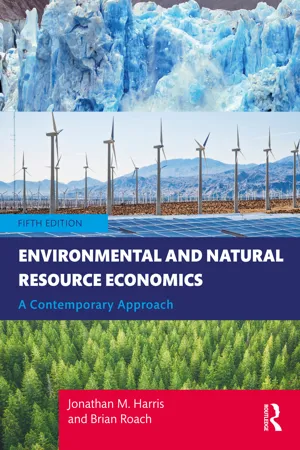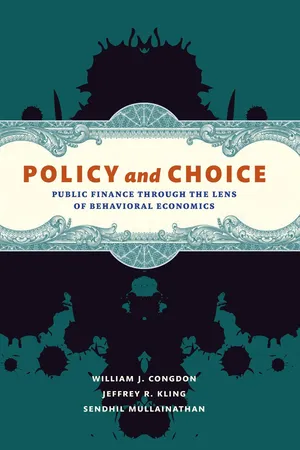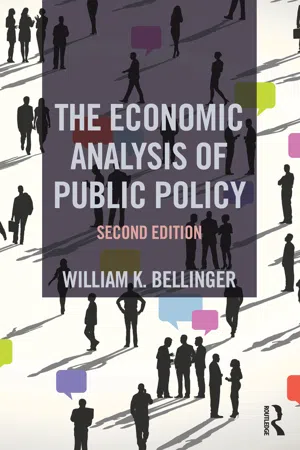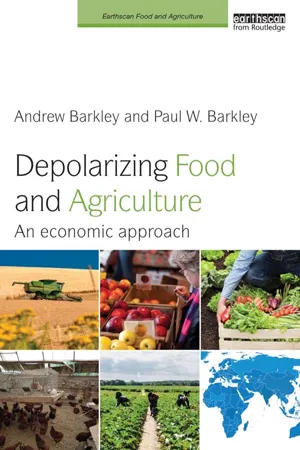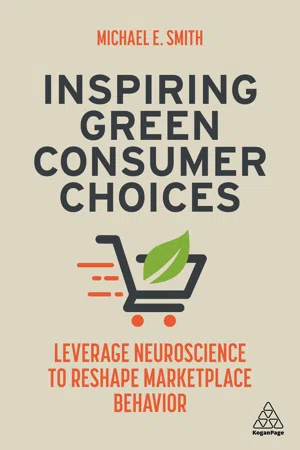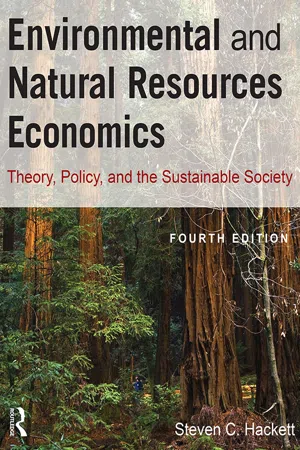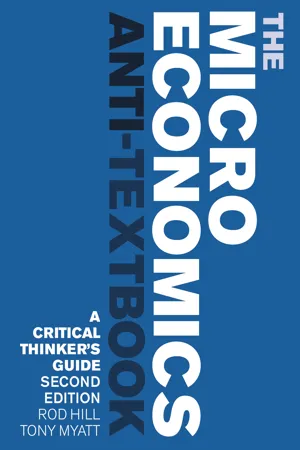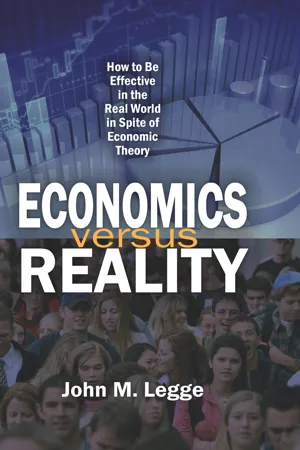Economics
Externalities and Public Policy
Externalities refer to the unintended side effects of economic activities on third parties, which are not reflected in market prices. Public policy aims to address externalities by either internalizing the costs through taxes and subsidies, or by regulating the behavior of economic agents. This is done to ensure that the social costs and benefits of economic activities are taken into account.
Written by Perlego with AI-assistance
Related key terms
Related key terms
1 of 4
Related key terms
1 of 3
11 Key excerpts on "Externalities and Public Policy"
- eBook - ePub
Health Economics
Demystifying Healthcare Economics, Your Guide to Informed Decisions and a Healthier Future
- Fouad Sabry(Author)
- 2023(Publication Date)
- One Billion Knowledgeable(Publisher)
For instance, manufacturing activities that cause air pollution impose health and clean-up costs on the entire society, whereas the neighbors of individuals who choose to fire-proof their homes may benefit from a decreased risk of a fire spreading to their homes. If there are external costs, such as pollution, the producer may decide to produce more of the product than he or she would if required to pay all associated environmental costs. Due to the fact that responsibility or consequence for self-directed action lies in part outside the self, externalization is present. If there are external benefits, such as public safety, the producer may produce less of the good than if they were compensated for the external benefits to others.Two British economists are credited with initiating the formal study of externalities, or "spillover effects": Henry Sidgwick (1838–1900) is credited with first articulating the concept of externalities, and Arthur C. Pigou (1877–1955) is credited with formalizing it.Because the effect produced on others, whether in the form of profits or costs, is external to the market, we use the term externality.A negative externality is any difference between the private and social costs of an economic agent's action or decision. A negative externality is, in simple terms, anything that imposes an indirect cost on individuals. Toxic gases released by industries or mines are an example of indirect costs; these gases cause harm to individuals in the surrounding area, who must bear the cost (indirect cost) of removing that harm. In contrast, a positive externality is any difference between the private and social benefits of an economic agent's action or decision. A positive externality is defined as anything that provides an indirect benefit to individuals and for which the producer is not compensated. For instance, planting trees improves the appearance of a person's property and cleans the surrounding area.In microeconomic theory, externalities are factored into competitive equilibrium analysis as the social effect, whereas the private market only factors direct economic effects. The social impact of economic activity is equal to the sum of indirect (externalities) and direct factors. Therefore, the Pareto optimal point is where the social marginal benefit equals the social marginal cost. - eBook - ePub
Environmental and Natural Resource Economics
A Contemporary Approach
- Jonathan M. Harris, Brian Roach(Authors)
- 2021(Publication Date)
- Routledge(Publisher)
Chapter 3
The Theory of Environmental Externalities
DOI: 10.4324/9781003080640-3Chapter 3 Focus Questions
- How can pollution and environmental damage be represented in economics?
- What economic policies can be instituted to respond to environmental problems?
- How and when can property rights be relied upon to solve environmental problems?
3.1 The Theory of Externalities
We saw in Chapter 1 that one of the core concepts of environmental economics is the theory of environmental externalities. Externalities were defined as impacts that affect the well-being of those outside of a market transaction. Externalities can be either positive or negative. The most common example of anegative externalityis pollution. If markets operate without any regulation, the production decisions of companies will not account for the social and ecological damages of pollution. Consumers also typically will not limit their purchases because of pollution caused by various goods and services. But comprehensive economic analysis considers not just the ways markets impact buyers and sellers, but how markets affect all members of society. (It may also be relevant to consider impacts on nonhuman species and on ecosystems in general—this issue will be dealt later in this chapter and also in Chapters 6 and 7 .) So when we analyze the overall impacts of a market, we need to account for the damages from pollution and other negative environmental impacts.- negative externality negative impacts of a market transaction affecting those not involved in the transaction.
In some cases, a market transaction can generate a positive externality - eBook - ePub
Policy and Choice
Public Finance through the Lens of Behavioral Economics
- William J. Congdon, Jeffrey R. Kling, Sendhil Mullainathan(Authors)
- 2011(Publication Date)
- Brookings Institution Press(Publisher)
31 Conversely, there can be cases of behavioral externalities in environmental decisionmaking.Finally, note that the externality framework developed by public finance may provide a useful way of thinking about inconsistent decisionmaking even when the consequences are primarily internal to the decisionmaker. Discussion of such cases—internalities—is given in box 5-1 .The Role of GovernmentAddressing externalities requires policymakers to resolve trade-offs about the relative social value of alternative courses of action. In particular, policy choices must reflect judgments about social welfare outcomes in alternative states of the world—for example, about the benefits of reducing carbon emissions through a corrective tax compared with the benefits of inaction or the costs of implementing a carbon reduction policy. Policy choices also express judgments on how to treat individuals.In the standard analysis of externalities, very little judgment of this sort is required of policymakers. The social welfare implications of choosing alternative states of the world follow nearly directly from the identification of the problem. There is some private equilibrium, with one set of outcomes, and it is compared to achievable equilibria under policy alternatives. Absent government intervention, for example, in the case of carbon emissions, individuals respond purely to private costs. Applying some intervention, such as a carbon tax, leads individuals to respond to a new set of incentives. In addressing negative externalities through price mechanisms, even the particular mechanisms creating those incentives are assumed to be relatively unimportant. A carbon tax and a cap-and-trade scheme for carbon emissions are roughly equivalent in terms of social welfare results under some standard assumptions. When there are important judgments to be made, they often have to do with the distributional implications of policies. For example, in the case of climate change, there is an important judgment regarding how to trade off the costs of carbon abatement to current generations against its benefits to future generations. - eBook - ePub
- William K. Bellinger(Author)
- 2015(Publication Date)
- Routledge(Publisher)
13 , which cover urban transportation and pollution policy, and those discussions depend on a clear understanding of the following concepts.Externalities can be harmful or helpful. For example, water pollution produced by farmers may negatively affect their neighbors or cities downstream. On the other hand, visitors to Hershey, Pennsylvania, are likely to enjoy the aroma rising from the chocolate factory near the center of town. Another example of a positive externality is the more familiar case of the beekeeper and the apple orchard. A beekeeper’s insects will provide great benefits to an orchard located next door through the pollination of its trees. This will happen whether or not the orchard owner pays for this benefit. Therefore, the pollination process is basically external, as are the benefits of pollination to the orchard owner. Of course, the beekeeper will experience a similar benefit from the apple orchard, a source of nectar for the bees.Introductory texts often start the economic analysis of externalities by drawing a distinction between the private, external, and social costs of production. Let’s assume that a factory on a river produces shoes and also water pollution that harms fishermen downstream. The production of these shoes will produce two types of costs, private production costs for the shoe company and external costs to the fishermen. Since both groups belong to society, society’s total costs include both the private and external costs.More explicitly, the firm’s production will lead to two different cost curves, one representing marginal private costs, and the other curve representing marginal social costs. The difference in height between the two curves will equal the marginal external cost or benefit for that unit of production (see Figure 4.8 - eBook - ePub
Depolarizing Food and Agriculture
An Economic Approach
- Andrew Barkley, Paul W. Barkley(Authors)
- 2014(Publication Date)
- Routledge(Publisher)
Chapter 6 . This chapter discusses externality issues in agriculture. Economic theory provides elegant analyses, background, and a strong case for effective public policy. However, real-world policies for the market failures that surround externalities and public goods are challenging to formulate and costly to regulate, enforce, and evaluate. Given that public policies redistribute income and wealth through resource use programs, it is little wonder that the policies relating to agriculture are controversial.ExternalityExternalities are present when the actions of one person affect another person. The external effects can be positive, such as when person A’s bees, which are raised for their ability to produce honey, pollinate person B’s fruit orchards. Or they can be negative, as when toxic chemical runoff finds its way into a downstream neighbor’s water supply. Markets do not always provide an optimal outcome in such situations, and the external events are referred to as “market failures.” Externalities will be analyzed in detail, and possible solutions to negative externalities associated with agricultural production will be explored.BOX 7.1 : ECONOMIC THINKING APPLIED TO STRONG OPINIONS REGARDING RISKMany environmental and consumer groups, including the Environmental Defense Fund, the National Resource Defense Council, the Environmental Working Group, and Greenpeace, oppose the use of agricultural chemicals. The claims against agricultural chemicals are often bold and acrimonious. Because of this, changes in how food is produced and processed can be, and often are, polarizing. But such claims are easily made, because it is costless to have an opinion. An actual major change such as a chemical ban, however, is often much more costly than an opinion or a claim. Such a change requires more thought, analysis, and careful review. While chemical use may require regulation, eliminating chemical use comes at substantial costs (Zilberman, 2012). When care is taken to communicate the full costs of policy changes, many individuals change their views from extreme to moderate. For example, in many cases some chemical use is warranted to maintain low food costs. Externality issues, that is, inadvertently harming others, can often be resolved through greater levels of knowledge and communication. When benefits and costs are explained to individuals and groups on both sides of an issue, agreement or compromise often follows. For example, the Environmental Working Group (EWG), a “think tank” headquartered in Washington, DC, provides careful monitoring, evaluation, and reporting of health risks associated with chemicals typically found on fruits and vegetables (EWG, 2013b). - eBook - ePub
Inspiring Green Consumer Choices
Leverage Neuroscience to Reshape Marketplace Behavior
- Michael E. Smith(Author)
- 2021(Publication Date)
- Kogan Page(Publisher)
This situation hides costs that might shift preferences if they were revealed. That is, we might consume less of a thing if all of its externalized costs were accounted for in its price. An “externality” can be conceived of as a cost or benefit that accrues to someone who did not choose to suffer or enjoy that cost or benefit. For reference, the word externality is also missing from Schumacher’s book. While in principle the term refers to both cost and benefits, in reality many key externalities are all about a short-term illusion of benefits. For consumers, those benefits are related to cheaper products when environmental impacts have been externalized. And for producers, those benefits are for higher profits for production processes that ignore environmental impacts. In reality, such short-term benefits reflect acts of borrowing from the future, and in the longer term the externalities that permitted them will need to be re-accounted for in terms of the collective costs of biosphere degradation.Figure 9.1 Expected Impact of Taxing a Negative ExternalityFigure 9.1 details The details of thee graph are as follows:The horizontal axis represents supply and the vertical axis represents price. Two left inclined lines representing environmental impact internalized and environmental impact externalized emerging from the origin. The externalized line intersects the plot (Q subscript 1, P subscript 1) and the internalized line intersects the plot (Q subscript 2, P subscript 2). A line representing demand passes through the following plots (Q subscript 1, P subscript 1) and (Q subscript 2, P subscript 2). The gap between the plots is labeled tax.In policy circles there is a growing effort to “internalize” such externalities so that they are more properly accounted for up-front, such that consumers and producers can be properly informed about the costs and benefits of their transactions and thus can make choices that better reflect them. For example, one could in principle correct for such market failures by adding a tax to the price of some product for which its creation or disposal imposes some externalized societal cost, which would in turn increase the costs to the consumers of that good while reducing the quantity of the injurious product demanded in the first place (Figure 9.1 - eBook - ePub
Environmental and Natural Resources Economics
Theory, Policy, and the Sustainable Society
- Steven Hackett, Sahan T. M. Dissanayake(Authors)
- 2014(Publication Date)
- Routledge(Publisher)
Chapter 7 .Summary
- Positive externalities are unpaid-for benefits to society generated as a by-product of production and exchange. When there are important positive externalities, market demand based on the private benefits of buyers understates the full social benefits of the good or service generating the external benefit. Consequently, too little of the good or service generating the positive externality is produced in otherwise well-functioning competitive markets. Subsidies represent a form of policy intervention that can enhance market efficiency by internalizing the positive externality. Positive externalities can also affect the supply curve, such as when there are knowledge spillover externalities.
- While the legal system is designed to protect property, open-access and public trust resources were not traditionally protected under common law from pollution harms and thus remain subject to degradation. The legal system does not function perfectly, of course, and so pollution harms to people, their homes, and other valuable objects that are property do regularly occur. One problem is in determining the source of the pollution when there may be very large numbers of emitters, as is the case with automobile exhaust.
- Negative externalities are uncompensated damage costs borne by members of society. These negative externalities are generated as a by-product of production and exchange. Profit-maximizing firms have an incentive to transform private costs into negative externalities (external costs) in the absence of regulation or reputation effects. When there are important negative externalities, market supply based on private costs to sellers is too large, leading to too much of the good or service generating the negative externalities being produced in otherwise well-functioning competitive markets. Pigouvian taxes represent a form of policy intervention that can enhance market efficiency.
- eBook - ePub
Economics in Christian Perspective
Theory, Policy and Life Choices
- Victor V. Claar, Robin J. Klay(Authors)
- 2015(Publication Date)
- IVP Academic(Publisher)
With positive externalities the total social benefit is even greater than the net benefit enjoyed by those involved in the market part of the activity. Suppose that you replace an old, shabby jacket with a new jacket that really suits you in fit and color. Of course the seller benefits, valuing your money in the cash drawer more than he or she values the jacket in the inventory. And you benefit, since you will feel good about your appearance and will be protected from the elements. But others may benefit as well, if your appearance in the new jacket makes you generally more enjoyable to be around.An obvious role for government, then, is to improve on market outcomes by encouraging more of the activities that generate positive external effects. If society enjoys a benefit beyond that considered by the parties to the transaction, then a wise government would do well to introduce policies that encourage more of those activities.On the other hand, negative externalities result when the producers or consumers creating the spillover are not forced to consider the full cost to society of their actions. For example, the reason that firms pollute is because they can use some natural resources (like clean air) to dispose of waste without paying for doing so. If there were a way to make a firm consider the full cost of all of its actions, it would reduce its activity levels. Therefore, just as wise economic policy should encourage more of those activities that lead to positive externalities, it should also discourage the activities that lead to negative ones.Stated another way, one role of government is to gently nudge the sub-optimal outcomes that sometimes result from market outcomes closer to the outcomes we would all hope for given a full accounting of all - eBook - ePub
The Microeconomics Anti-Textbook
A Critical Thinker's Guide - second edition
- Rod Hill, Tony Myatt(Authors)
- 2021(Publication Date)
- Zed Books(Publisher)
Chapter 9 .)As we’ve argued in Chapter 5 , business power combined with a poorly informed public often plays a central role in shaping public policy, and that sensitive topic is off limits. As a result, the textbooks give the misleading impression that externalities and related market failures involving public goods and common access resources are minor blots on the landscape.2.1 Externalities in realityLet’s briefly consider some actual externalities to support our contention that they deserve a central place in the analysis of the modern economy. At the same time, we consider whether these externalities are likely to be adequately addressed in light of the realities of power and information in the societies involved.Meta-externalitiesThe classic textbook externality takes place entirely within the economic system: for example, a manufacturing plant puts waste into a river which harms a downstream fishery. Instead, meta-externalities are, as Neva Goodwin puts it, the side effects ‘of the economic system, as a whole, on the social and ecological environment in which it is embedded — and on whose health the continuing health and vitality of the economy depends’.8 The term meta-externality does not appear in any standard textbook, despite their importance.The economic activities contributing to climate change have created the most serious negative meta-externality. As noted earlier, because of its critical importance, we devote the Postscript to a text/anti-text case study of climate change. Here, let’s consider some other examples, generally unmentioned by the textbooks.One reason that meta-externalities are ignored in the standard text is because economic life is typically portrayed in isolation from its social and environmental context. As a result, the connections between these are often overlooked. - eBook - ePub
- Y. Kanemoto, T. Miyao(Authors)
- 2013(Publication Date)
- Taylor & Francis(Publisher)
Fundamental Theorem of Welfare Economics, a competitive equilibrium is efficient in the Pareto optimal sense if all goods are private goods and no externalities exist. This result, however, breaks down if there are externalities. An individual decision maker who generates externalities does not take into account external costs (or benefits) imposed on others. His decision must therefore be corrected to account for external effects. If, for example, the externality is harmful, the generating agent should be induced to diminish the externality compared with what private self-intesest would dictate. Externalities thus present a case of potential market failure where government intervention may be called for to guide a decentralized market system toward a point where resource allocation is efficient.It is, however, too early to jump to the conclusion that government actions are always justified when there are externalities. For example, individuals who suffer from water pollution have an incentive to get together and bribe firms to reduce pollution. The reason why this may not happen is that the transactions costs to set up a market for pollution may be too high. If the government has to incur the same transactions costs as private individuals, then government intervention cannot improve resource allocation. Government intervention is justified, therefore, only if the coercive power of the government reduces the transactions costs.Even if government intervention is justifiable, the government has to choose an appropriate policy among alternative policy measures. For example, introducing a Pigouvian tax/subsidy system is one way of modifying individual actions to achieve an efficient allocation. A tax placed on pollution will tend to reduce the amount of externality. If a corrective tax is set equal to the marginal externality costs suffered by others, an efficient allocation is attained. One problem with the Pigouvian tax/subsidy, however, is that it usually requires high administrative costs. In some cases, direct regulation of private activities such as a ceiling on pollution emissions and a control of land use may be less costly. Moreover, the government might also have to resort to cruder measures. For example, a Pigouvian tax/subsidy system for traffic congestion requires congestion tolls whose levels are different for different roads depending on the severity of congestion. Implementation of such a system is obviously very costly and the only practical policy tool may be a uniform gasoline tax whose rate is the same in all roads. In this situation, we see that while the uniform tax is an imperfect tool, it may still be better than no tax at all. - eBook - ePub
Economics versus Reality
How to be Effective in the Real World in Spite of Economic Theory
- John Legge(Author)
- 2017(Publication Date)
- Routledge(Publisher)
Less ideological economists have observed that many transactions do inflict costs, or sometimes benefits, on third parties. Such costs or benefits are referred to as externalities. Neoliberal theorists argue that either there are no significant negative externalities, or if there are significant externalities, the costs inflicted by government action to rectify them would exceed the harm that they cause.Economists going back to Adam Smith1 have observed that there are some necessary services that cannot be provided by a market, or at best cannot be provided satisfactorily. Such services and institutions are referred to as public goods, since without them the majority of the population, and the aggregate population, would be worse off.Examining the real world shows that there are, in fact, many externalities arising in the normal course of the operation of a capitalist system, and there are many public goods that an unregulated market would not provide.Public Goods
A public good is one that is available to all the people in a community or to none of them; the classic example is “freedom from foreign invasion.” If one’s country is invaded and occupied, this affects all the residents: it is impossible for one household to be invaded and occupied by foreign enemies while its neighbors remain free of such problems. For this reason even the most ardent libertarians support the existence of national defense forces financed from general taxation.Mortality from disease was far higher in the nineteenth century than it is today, and life in the great cities was particularly unhealthy, with typhoid and cholera carrying off as much as 3 percent of the population in some years. While the poor suffered more than the rich, no one was immune: Queen Victoria’s consort, Prince Albert, died relatively young, probably of typhoid fever. Doctors had various explanations for illness and contagion, but it wasn’t until the work of Louis Pasteur in the 1860s that the germ theory of disease became established. Pasteur and those convinced by his arguments and demonstrations had to overcome the protests of the more conservative doctors who were unwilling to see their learning discredited and who resented the implication that their poor hygiene had killed many of their patients.
Index pages curate the most relevant extracts from our library of academic textbooks. They’ve been created using an in-house natural language model (NLM), each adding context and meaning to key research topics.
Explore more topic indexes
Explore more topic indexes
1 of 6
Explore more topic indexes
1 of 4

